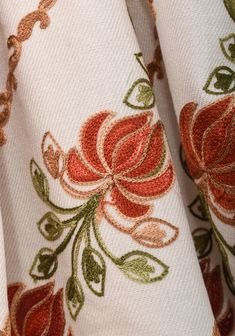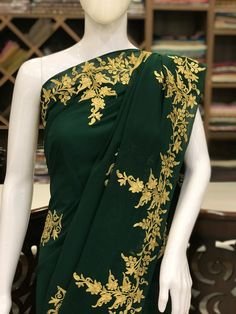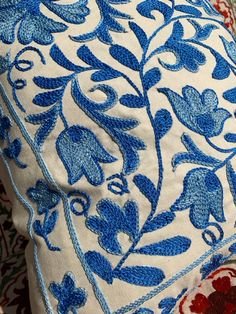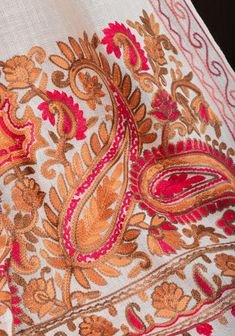Semi and Kashmiri Stitch
Welcome to today’s class on two exquisite embroidery stitches: Semi Stitch and Kashmiri Stitch. These techniques originate from rich cultural traditions and are celebrated for their intricate designs and artistic flair. Throughout this session, we will delve into the origins, characteristics, applications, and practical exercises to master these stitches, offering you a comprehensive understanding of their beauty and versatility.
Materials Needed:

- Fabric: Choose a suitable fabric for practicing embroidery stitches, such as cotton, linen, or silk, depending on the desired project.
- Embroidery Threads: Select threads in various colors and textures, including silk or cotton embroidery floss, to complement your fabric and design.
- Needles: Embroidery needles in different sizes to accommodate various thread weights and fabric thicknesses.
- Embroidery Hoop: Optional but recommended for stabilizing the fabric and maintaining tension while stitching.
- Scissors: Sharp scissors for cutting threads and trimming excess fabric.
- Marking Tools: Fabric chalk, water-soluble pens, or tailor’s chalk for transferring designs onto the fabric.
- Reference Materials: Patterns or design templates to guide your embroidery work.
Understanding Semi Stitch:
1. Definition and Characteristics:
- Semi Stitch: A type of chain stitch characterized by its looping appearance, forming a continuous line of connected loops on the fabric.
- Appearance: Creates a textured and three-dimensional effect, ideal for outlining and filling designs.
2. Origins and Cultural Significance:
- Origin: Semi stitch has its roots in traditional Indian embroidery, particularly associated with regions like Rajasthan and Gujarat.
- Cultural Significance: Often used in embellishing garments, home decor items, and ceremonial textiles, reflecting cultural motifs and symbolism.
3. Applications of Semi Stitch:
- Decorative Outlining: Use semi stitch to outline floral patterns, geometric motifs, and borders on garments, cushions, or table linens.
- Filling Stitches: Fill larger areas or shapes with semi stitch to create textured surfaces and add depth to embroidery designs.
Practical Session: Learning Semi Stitch

1. Setting Up:
- Fabric Preparation: Cut a piece of fabric and secure it in an embroidery hoop for stability.
- Thread Selection: Choose an embroidery thread color that contrasts or complements your fabric for visibility and aesthetic appeal.
2. Executing Semi Stitch:
- Starting Point: Bring the needle up through the fabric at the starting point of your design outline.
- Stitching Technique: Insert the needle back into the fabric close to the starting point, leaving a loop of thread on the surface.
- Continuation: Repeat the process, keeping the loops uniform in size and spacing to maintain consistency.
- Completing the Line: Continue stitching along the design outline, adjusting tension as needed for even loops.
3. Variations and Design Flexibility:
- Stitch Density: Vary the density of loops to create different textural effects, from tightly packed loops for solid fills to spaced loops for delicate outlines.
- Color Play: Experiment with blending multiple thread colors within the same design to add depth and dimension.
Understanding Kashmiri Stitch:
1. Definition and Characteristics:
- Kashmiri Stitch: A traditional embroidery technique from Kashmir, known for its intricate and elaborate designs.
- Technique: Combines elements of chain stitch, satin stitch, and sometimes couching, creating densely embroidered surfaces with a raised, padded effect.
2. Cultural Heritage and Design Elements:

- Artistic Tradition: Kashmiri Stitch is integral to the cultural heritage of Kashmir, reflecting influences from Persian, Mughal, and Central Asian art.
- Design Elements: Features intricate patterns such as paisleys, florals, and intricate motifs, often embellished with metallic threads, sequins, and beads.
3. Applications of Kashmiri Stitch:
- Textile Art: Embellish shawls, sarees, jackets, and home decor items with Kashmiri Stitch to add luxury and elegance.
- Bridal Wear: Adorn bridal attire with Kashmiri Stitch for its opulent and celebratory aesthetic.
Practical Session: Learning Kashmiri Stitch
1. Fabric and Thread Selection:
- Fabric Choice: Use fine fabrics like silk or pashmina wool, traditionally used for Kashmiri embroidery.
- Thread Variety: Incorporate silk threads, metallic threads, and embellishments like beads and sequins for authentic Kashmiri embroidery.
2. Stitching Techniques:
- Chain Stitch Base: Begin with a foundation of chain stitch or satin stitch to outline the design.
- Padded Stitching: Layer additional threads or padding stitches to create a raised effect, enhancing the texture and dimensionality of the embroidery.
- Detailing: Add intricate details using couching, French knots, or seed stitches to fill spaces and highlight design elements.
3. Finishing Touches:
- Securing Threads: Knot threads securely on the wrong side of the fabric and trim excess thread close to the knots.
- Pressing: Gently press the embroidered area on the wrong side using a pressing cloth to flatten any puckering and enhance the finished appearance.
Advanced Techniques and Variations:

1. Incorporating Beads and Sequins:
- Enhanced Embellishment: Combine Kashmiri Stitch with beadwork and sequins to create a luxurious and textured surface.
2. Modern Interpretations:
- Contemporary Designs: Adapt traditional Kashmiri motifs and techniques to modern fashion and home decor, blending heritage with innovation.
3. Personalizing Designs:
- Customization: Customize Kashmiri Stitch designs to reflect personal style preferences and cultural heritage, incorporating symbolic motifs and colors.
Conclusion:
Semi Stitch and Kashmiri Stitch are distinguished embroidery techniques that showcase the artistry and craftsmanship of their respective cultural origins. By mastering these stitches, you gain not only technical proficiency but also a deeper appreciation for the cultural narratives and artistic traditions they embody. Through practice, experimentation, and attention to detail, you can create exquisite embroidered pieces that captivate the eye and celebrate the rich heritage of textile arts.
